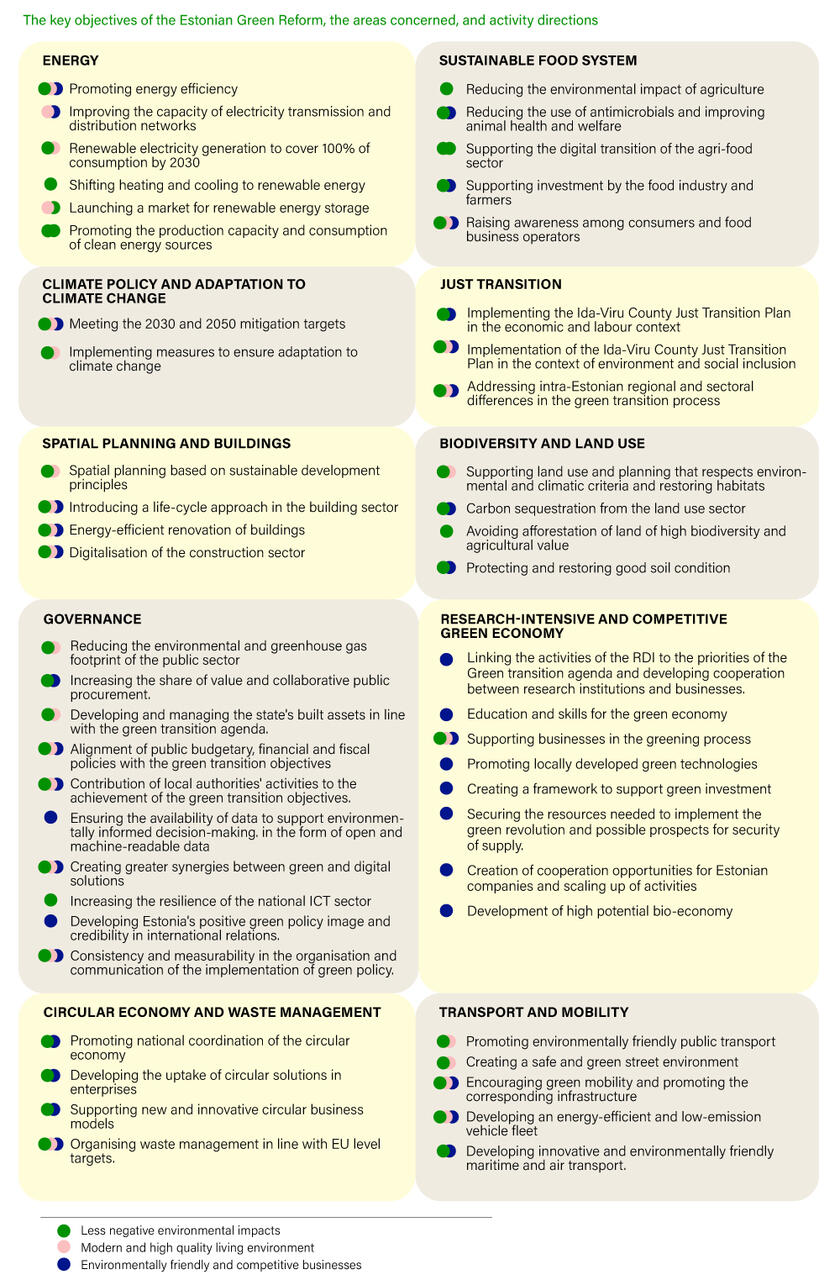Embark on a unique hackathon tailored for tech-savvy specialists in the dynamic fields of energy, sustainability, and digitalization! This exclusive event focuses on leveraging digital tools and data to drive and champion a green transition, the most significant change of our era.
University of Tartu together with Garage48 invite you to transform your digital expertise into solutions for a sustainable future. Let's turn our hackathon ideas into tangible, impactful projects and pave the way for a greener tomorrow!
The hackathon is brought to you in partnership with Cleantech Estonia, Environmental Investment Centre, Startup Estonia, Estonian University of Life Sciences, Nordic Council of Ministers, Tehnopol, Eesti Energia, sTARTUp Day and Jõhvi Concert Hall.
WHAT?
Our hackathon revolves around a central question: How can digital skills, knowledge, and data be wielded to foster the societal change we aspire to achieve? Join us in co-creating innovative solutions under the mentorship of industry experts and state representatives, ensuring that the proposed ideas are not only visionary but also feasible within specific domains.
We're actively seeking cutting-edge tools and services to facilitate the transition away from fossil fuels, nurturing and advancing our green journey. Embrace the power of incentivizing and co-creation, as your ideas can shape policies and contribute to a positive impact on the future. Entrepreneurs play a crucial role in envisioning the utilization of data and services that could attract them to the region and towards more green products, fostering a more vibrant ecosystem.
WHY?
Our societies are undergoing active change on two fronts – digitalization and green transition. This poses challenges and opportunities. Addressing climate change and energy crises on an individual, municipal, and national level comes with a sense of urgency. At the same time, we face digitalization on every level, which comes with collecting large sets of diverse data.
Local municipalities often grapple with challenges in supporting large-scale change. Your ideas on how small tweaks in local governance can enhance efficiency and deliver better results are essential. To fully achieve the transition, we also need insights into individual behavior changes and broader macro-level shifts aligning with our mission.
SUB-CHALLENGES
Get acquainted with more specific calls to action from the "Sub-challenges" sub-page 👆.
Nordic Council of Ministers' Office in Estonia is calling for solutions for digital support to Ida-Virumaa green tourism
Tehnopol is inviting participants to develop solutions for greening the movie industry
Eesti Energia is up for making benefits of energy storage understandable for ordinary users and customers.
WHERE?
We will meet at the heart of Estonia’s green transition region – Ida-Virumaa. The hackathon will take place in Jõhvi Concert Hall.
You will be provided with catering and access to the venue throughout the whole event.
Accommodation is provided to all participants at Nele Hostel - you will have a spot in a twin or triple room, if you wish, free of charge. Just let us know as you're registering for the hackathon.
The location is easily accessible by train, bus and car.
PRIZES
PRE-EVENT
To introduce the green transition challenge, potential of the data, share some great examples of the digi+green solutions out there, and introduce the hackathon format, we’ll host a webinar on April 23 at 18.00-20.00 EEST.
Check the recap from the "Pre-event" sub-page 👆.
THE DATA
Check out data overview for the hackathon from the "Data" sub-page 👆.
HOW IT WORKS
Get inspiration from the pre-event happening on April 23.
Sign up for the hackathon.
At the beginning of the hackathon we will form teams around the best ideas pitched at the opening and by participants with various skillsets and motivation to make the idea into a reality.
During the 48 hours, you will work with your team and with the mentors to build a working prototype by the end of the hackathon and sell it to the jury
- All the finished prototypes will be evaluated and the best teams will get rewarding prizes that will give you the tools to develop their ideas even further!
REGISTER TO THE HACKATHON
SIGN UP by 23.59 May 8th 2024 - you’re welcome with or without an idea, together with team members, or on your own.
In case you have any questions, contact us at kadri@garage48.org.
The hackathon is organised by the ECePS ERA Chair that has received funding from the European Union’s Horizon 2020 research and innovation programme under grant agreement No 857622. The event is supported by the CEESEU-DIGIT project, funded by the European Union’s Programme for the Environment and Climate Action (LIFE 2014-2020) under grant agreement n° LIFE 101077297.
Views and opinions expressed are however those of the author(s) only and do not necessarily reflect those of the European Union or European Research Executive Agency. Neither the European Union nor the granting authority can be held responsible for them.
Friday, 10 May
17:30 - Check-in and snacks
18:30 - Opening
18:45 - Pitching ideas in 90”
20:30 - Team formation
21:00 - Teamwork begins
Saturday, 11 May
9:00 - Breakfast
10:00 - Checkpoint #1
11:30 - Mentoring starts
13:00 - Lunch
14:00 - Pitch drill ABC
18:00 - Checkpoint #2
19:00 - Dinner
20:00 - Teamwork continues
Sunday, 12 May
9:00 - Breakfast
10:00 - Checkpoint #3
11:00 - Pitch drill session #1
13:00 - Lunch
14:00 - Pitch drill session #2
16:00 - The finals
18:00 - Refreshment break and the jury deliberates
19:00 - Award ceremony
GREEN TRANSITION DIRECTIONS AND PRIORITIES IN ESTONIA
We have set an ambitious target, both at the European Union level and in Estonia itself, to achieve climate neutrality by 2050. Achieving this target will have a significant and direct impact on the choices we face in organising our societies and economies. At the end of 2023, Estonia finalised its Green transition action plan to guide us on this path.
The green transition is a balanced transformation of society and the economy, reducing the negative impact of human activity on the environment, strengthening the competitiveness of businesses and thereby providing our people with a quality life in a clean environment.
It is true that climate change in Estonia is not yet as extreme and socially painful as in many other countries of the world and the European Union. However, scientists' forecasts show that already this century we may face, among other changes, the following:
Temperatures, which have risen faster in Estonia than the global average in the second half of the 20th century, will continue to rise. As a consequence, ice and snow cover will decrease and winters will become warmer, with more frequent hot spells and droughts in summer, which are damaging to people, agriculture, and nature.
Increase in precipitation, especially in winter, and associated flooding - winter precipitation is expected to increase by up to 80%; increased maintenance of drainage ditches and systems and dams; increased river bank erosion and consequent bank stabilization; pressure to relocate housing/utilities; increased pumping of mining water, etc.
Rising sea levels will lead to bank erosion, threats to riparian structures, pressure to relocate buildings, etc.
Storms will become more frequent, which will require additional costs to increase the resilience of both infrastructure and structures, and to increase the capacity to deal with the aftermath of storms.
Projected changes in main climate parameters (e.g. precipitation, air temperature, etc.) will affect biodiversity as a whole, as well as different ecosystems (terrestrial, freshwater and marine) and the benefits and services they provide to society.
In our strategic planning at the national, local, and organizational levels, we must take these into account to ensure the future success of our activities and societal welfare.
THE KEY OBJECTIVES OF GREEN TRANSITION
1. Reducing negative environmental impacts
Mitigating and adapting to climate change, reducing pollution levels and preserving biodiversity will require systemic change in the areas of energy production and use reduction, transport and infrastructure construction and use, food and agriculture, buildings and spatial planning, forestry, land use and agriculture, and the use of resources and materials.
2. Designing a modern and high-quality living environment
A quality living environment is an element of overall well-being, and public spaces and buildings play a central role in this. The living environment is one of the vehicles of our culture. Its quality affects the quality of life of every individual. We need to work together to make the living environment greener, safer and more inspiring with every spatial decision.
3. Contributing to the development of competitive and environmentally friendly business
A greener and more sustainable economic model, in other words development geared towards the promotion of a green economy, minimises environmental risks and pressures on natural resources, is low greenhouse gas emitting, resource-efficient, socially inclusive and improves human well-being and social justice. By shifting to a new economic model, we will maintain and enhance our position in the EU market.
Areas of the Green reform Action Plan have each its own sub-objectives to narrow things down to more tangible activities:
It is crucial also to understand why some areas are of higher priority, as shown in the following table:
Priorities | Explanation |
Renewable energy 100%. Adoption of a package of legislative amendments to accelerate the development of renewable energy. | Necessary both to reduce negative environmental impacts and to maintain the competitiveness of the economy. |
Increasing the volume and speed of building renovation. | Necessary to increase the energy efficiency of the building stock, to reduce dependence on fossil fuels, to reduce expenditure on heating. |
Drafting and adoption of the Climate Change Act | Necessary to lay down obligations for different sectors, increase investment security |
Planning of investments needed to meet 2030 climate targets in the preparation of the national budget strategy (in the annual RES process). | Necessary to reduce greenhouse gas emissions at a pace consistent with the targets set. |
Significantly improving the efficiency and accessibility of public transport operations. | Necessary to reduce emissions from the transport sector and car ownership. |
Comprehensive spatial planning at both strategic and implementation level | Necessary to create a modern and high-quality living environment |
Drawing up of action plans for the wholesale reform of businesses and sectors in partnership between the public and private sectors. | Necessary to enhance cross-sectoral cooperation, to create green reform as an opportunity, to support and encourage the greening of sectors. |
Increasing the share of green public procurement to 25% by 2025. | Necessary to stimulate the supply and development of green products and services |
Supporting land use and planning compatible with environmental and climate objectives and habitat restoration. | Necessary to strike a balance between land use, use of bio-resources, meeting climate objectives and protecting biodiversity. |
Developing a nationwide just transition plan | To ensure a just transition across all sectors and all regions of Estonia |
More detailed descriptions are presented in the Green Reform action plan for Estonia, available in Estonian on the Ministry of Climate homepage: https://valitsus.ee/valitsuse-eesmargid-ja-tegevused/rohepoliitika/tegevusplaan
Europe and national governments are already collecting various data about various elements connected to social, economic, and environmental aspects of green transition and society. In addition, there is a lot of „closed data“ that is protected and collected by local municipalities and could also potentially be used when developing local e-services with higher data protection.
Below you can find an overview of various datasets open to public that can be used to build designated services to support and guide green transition:
Name of dataset | Description of dataset (2-3 sentences) | Link to dataset |
European data | The official portal for European data | https://data.europa.eu/en |
Global Forest Change 2000-2022 | Results from time-series analysis of Landsat images in characterizing global forest extent and change from 2000 through 2022. | https://data.globalforestwatch.org/documents/941f17325a494ed78c4817f9bb20f33a/explore |
Aboveground Live Woody Biomass Density | This is a global, wall-to-wall map of aboveground biomass (AGB) at approximately 30-meter resolution. | https://data.globalforestwatch.org/datasets/e4bdbe8d6d8d4e32ace7d36a4aec7b93_0/about |
Net greenhouse gas emissions (EU) | The indicator measures total national emissions (from both ESD and ETS sectors) including international aviation of the so called ‘Kyoto basket’ of greenhouse gases, including carbon dioxide (CO2), methane (CH4), nitrous oxide (N2O), and the so-called F-gases (hydrofluorocarbons, perfluorocarbons, nitrogen triflouride (NF3) and sulphur hexafluoride (SF6)) from all sectors of the GHG emission inventories (including international aviation and indirect CO2). | https://ec.europa.eu/eurostat/databrowser/view/SDG_13_10__custom_1300365/bookmark/table?lang=en&bookmarkId=bf32e957-0096-48fc-b9a2-e127f51a090d |
Climate-related economic losses (EU) | The indicator measures the economic losses from weather and climate-related events. In addition to the annual figures, a smoothed time-series based on 30-year averages is presented. | https://ec.europa.eu/eurostat/databrowser/view/SDG_13_40__custom_3605211/bookmark/table?lang=en&bookmarkId=f0555f75-f0ac-4333-8d74-d1303f200da1 |
Share of renewable energy in gross final energy consumption by sector (EU) | The indicator measures the share of renewable energy consumption in gross final energy consumption according to the Renewable Energy Directive. The gross final energy consumption is the energy used by end-consumers (final energy consumption) plus grid losses and self-consumption of power plants. | https://ec.europa.eu/eurostat/databrowser/view/SDG_07_40__custom_2190966/bookmark/table?lang=en&bookmarkId=749c1328-331e-4c33-bbe7-7232f05c0c87 |
Statistics for the European Green Deal | Areas: Greenhouse gas emissions by sector, Forest and other wooded land, Protected areas, Common bird index, Raw material consumption (RMC), Circular material use rate, Gross domestic expenditure on R&D, Circular material use rate, R&D Expenditures, Renewable Energy, Primary energy consumption, Household energy consumption, Organic farming area, Nitrate in groundwater, population unable to keep a warm home, Greenhouse gas emissions intensity of employment, High-speed internet, zero-emission vehicles, passage transport, freight transport, consumption of hazardous chemicals, Premature deaths due to exposure to fine particulate matter (PM2.5), generation of waste, environmental tax revenue, environmental protection expenditures. | https://ec.europa.eu/eurostat/cache/egd-statistics/ |
Global population that is undernourished | Share of individuals that have a daily food intake that is insufficient to provide the amount of dietary energy required to maintain a normal, active, and healthy life. | https://ourworldindata.org/grapher/prevalence-of-undernourishment |
Global population poverty | Extreme poverty is defined as living below the International Poverty Line of $2.15 per day. This data is adjusted for inflation and for differences in the cost of living between countries. | https://ourworldindata.org/grapher/share-of-population-in-extreme-poverty |
Death rate from indoor air pollution vs. share in extreme poverty, 2019 | Age-standardized death rates from illness attributed to household air pollution from solid cooking fuels, measured per 100,000 individuals versus the share of the total population living below the International Poverty Line of $2.15 per day. | https://ourworldindata.org/grapher/death-rates-from-indoor-air-pollution-vs-share-of-population-in-absolute-poverty |
Household air pollution deaths by region, 1990 to 2019 | Annual number of premature deaths attributed to household air pollution from the use of solid fuels for cooking and heating. Solid fuels include the use of crop wastes, dung, charcoal and coal for indoor cooking. | https://ourworldindata.org/grapher/household-air-pollution-deaths-by-region |
Share of rural vs. urban population with electricity access, 2020 | Having access to electricity is defined in international statistics as having an electricity source that can provide very basic lighting, and charge a phone or power a radio for 4 hours per day. | https://ourworldindata.org/grapher/share-of-rural-population-with-electricity-access-vs-share-of-total-population-with-electricity-access |
CO₂ and Greenhouse Gas Emissions | Carbon dioxide (CO₂) emissions from fossil fuels and industry. Land-use change is not included. | https://ourworldindata.org/co2-and-greenhouse-gas-emissions |
Global Data on Energy | Global data on: access to energy, energy production and consumption, electricity mix, fossil fuels, renewable energy, nuclear energy, energy country profiles. Also, there are many mixed datasets such as energy poverty and indoor air pollution, the number of people without electricity, access to clean fuels for cooking, global comparisons of energy consumption etc. | https://ourworldindata.org/energy |
Global datasets on Clean Water | Global data on clean water: Share of deaths attributed to unsafe water sources, Share using safely managed drinking water | https://ourworldindata.org/clean-water |
Nordic Council of Ministers' Office in Estonia: Digital support to green tourism in Ida-Virumaa
Representing the office of the Nordic Council of Ministers, we're here to present a unique challenge that resonates with both our organization and the Ida-Viru region. In this picturesque area, where nature intertwines with community well-being, we're seeking your expertise to revolutionize sustainable tourism and mental health practices.
Picture this: pristine trails winding through lush forests, cycling routes embracing serene landscapes, and opportunities for families to bond amidst the beauty of nature. But we need your help to digitize and enhance these experiences.
Your mission, should you choose to accept it, is to harness the power of digitalization and artificial intelligence to create a platform or app. This tool will not only promote sustainable nature tourism but also foster mental well-being and active lifestyles for locals and tourists alike.
From mapping out interactive trails to designing immersive experiences for families, the possibilities are endless. Let's leverage technology to preserve nature, nurture mental health, and empower communities in Ida-Viru.
Are you up for the challenge? Join us as we pave the way for a greener, happier future!
Tehnopol: Greening the movie industry
The aim is to find solutions to support the green thinking of the IDA Hub, a film and multimedia innovation hub, soon to be built with the support of the Tehnopol Startup Incubator. The film industry has a significant ecological footprint, but at the same time, the whole world is moving towards the implementation of a greener film industry, which is also one of the core values of the IDA Hub. We are therefore looking for ideas that can help reduce the film industry's environmental impact by making the sector more sustainable, efficient, and people-friendly through technology. We are looking for solutions to optimize the various processes, data, materials, transport, and other aspects of film production. The ideal solutions would be those that can be applied to other areas of life, thus allowing for scalability of solutions across different sectors and expansion, for example to other markets.
Eesti Energia: Making benefits of energy storage understandable for ordinary users and customers
Award for the top solution: 1500€
Storage solutions are essential in today's energy industry for integrating renewable sources like solar and wind, balancing supply and demand by storing excess energy and releasing it when needed. They enhance grid stability and reliability by providing frequency regulation and voltage support, contributing to a more resilient energy infrastructure. These solutions also facilitate peak shaving and demand management, reducing strain on the grid and lowering electricity costs. Additionally, energy storage systems offer backup power during grid outages, ensuring continuity for critical infrastructure and enhancing overall system resilience. They play a crucial role in managing the electricity needed for transportation, including through vehicle-to-grid technology. Energy storage technologies improve system efficiency by capturing and delivering excess energy, while also providing flexibility for utilities to optimize operations and adapt to market changes. In summary, storage solutions are indispensable for a sustainable, reliable, and resilient energy system capable of meeting the challenges of today's energy landscape. However, storage solutions are expensive and their impact largerly not measured. During hackaton the teams could investigate and come up with a soultion how to make these complex systems and their impact understandable for a regular consumer.
18:00 Opening words
18:05 Introduction of the Ida-Virumaa challenge
Elis Vollmer, Project Manager at University of Tartu.
18:14 Tehnopol sub-challenge: "Greening the movie industry"
Presented by Olga Kurdovskaya, Film and multimeedia Accelerator program manager at IDA Hub
18:17 Nordic Council of Ministers Office in Estonia sub-challenge: "Ida-Virumaa and green tourism"
Presented by Jevgeni Timoštšuk, Programme Coordinator of Narva Branch Office at Nordic Council of Ministers' Office in Estonia.
18:20 Developing digital tools and services on EU and national level to support green transition + Q&A
Presented by Luukas Ilves, Former GCIO of Estonia
18:45 Use of data for digital tools - opportunities and challenges + Q&A
Presented by Sofia Paes, Advisor on data at Estonian Ministry of Communications and Economic Affairs
19:10 Using AI and machine learning to develop better e-services and e-tools + Q&A
Presented by Martin Rebane, Expert on AI and machine learning, Tartu Science Park.
19:35 Hackathon preparation ABC + Q&A
Check out the pre-event recap: https://www.facebook.com/elis.vollmer/videos/970505114645077?idorvanity=2180893068929515






.png)








